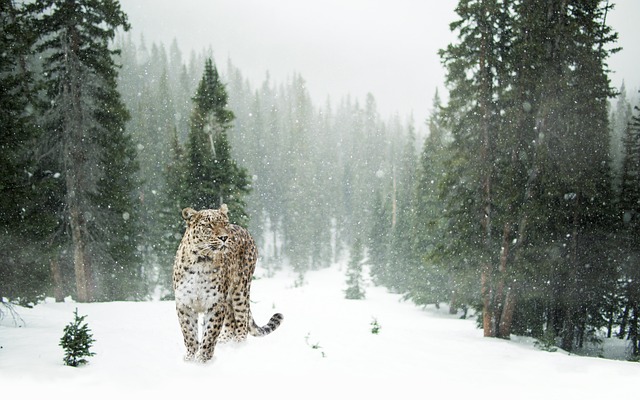The snow leopard (Panthera uncia), often referred to as the “ghost of the mountains,” is a solitary and elusive big cat native to the rugged, high-altitude regions of Central and South Asia. Known for its striking beauty and remarkable adaptations to extreme environments, the snow leopard is a symbol of conservation efforts in fragile ecosystems. Below is a detailed overview:

Physical Description
Snow leopards are medium-sized big cats with features uniquely suited to cold, mountainous environments:
- Size: Snow leopards measure 75–150 cm (30–59 inches) in body length, with a tail length of 80–105 cm (31–41 inches).
- Weight: They typically weigh between 22–55 kg (49–121 lbs), with males being larger than females.
- Fur: Their thick, long fur is smoky gray or cream-colored with black rosettes and spots, providing excellent camouflage in rocky terrains.
- Tail: The long, bushy tail helps with balance and doubles as insulation during rest.
- Paws: Their large, fur-covered paws act as natural snowshoes, distributing weight and providing traction on snow and ice.
Habitat and Distribution
Snow leopards inhabit some of the world’s harshest and most remote environments:
- Range: They are found in 12 countries, including Afghanistan, Bhutan, China, India, Kazakhstan, Kyrgyzstan, Mongolia, Nepal, Pakistan, Russia, Tajikistan, and Uzbekistan.
- Elevation: They typically live at elevations of 3,000–5,500 meters (9,800–18,000 feet) in mountainous regions.
- Preferred Habitat: Snow leopards favor steep, rocky slopes and alpine meadows, often near cliffs and ridges for hunting and escape from predators.
Diet and Hunting Behavior
Snow leopards are carnivorous apex predators with specialized hunting techniques:
- Primary Prey: They primarily hunt ungulates such as Himalayan blue sheep (bharal), ibex, argali sheep, and marmots.
- Occasional Prey: They may also hunt smaller mammals like hares and birds or scavenge carrion.
- Hunting Method: Snow leopards rely on stealth and ambush, using their powerful hind legs to leap distances of up to 15 meters (50 feet) to catch prey.
- Consumption: A single kill can sustain a snow leopard for up to two weeks.
Behavior and Social Structure
- Solitary Lifestyle: Snow leopards are solitary, except during mating season or when a mother is raising cubs.
- Territoriality: Each individual has a home range that overlaps slightly with others. Males have larger territories than females.
- Activity Patterns: They are crepuscular, most active during dawn and dusk.
- Communication: They communicate through scent marking, vocalizations (a yowl-like call), and scratching on trees or rocks.
Reproduction
- Mating Season: Snow leopards breed between January and March.
- Gestation Period: Females give birth after a gestation of 90–100 days.
- Litter Size: A typical litter consists of 1–5 cubs, with 2–3 being most common.
- Cubs: Cubs are born blind and helpless, staying with their mother for up to 18–22 months before becoming independent.
Adaptations
Snow leopards possess several adaptations to thrive in cold, high-altitude environments:
- Thick Fur: Their dense, insulating fur keeps them warm in freezing temperatures.
- Nasal Cavities: Enlarged nasal passages help them breathe thin, cold air.
- Muscle Strength: Their powerful limbs enable them to climb steep slopes and leap across rocky terrains.
- Camouflage: Their patterned coat blends seamlessly with rocky environments, aiding in hunting and avoiding detection.
Lifespan
- In the Wild: Snow leopards live 10–12 years in the wild.
- In Captivity: They can live up to 15–18 years under managed care.
Cultural Significance
- Symbolism: Snow leopards hold cultural significance in many mountain communities, often seen as spiritual or mythical creatures.
- Ecotourism: They attract wildlife enthusiasts, generating revenue for local communities.
Conservation Status
- IUCN Status: Vulnerable.
- Population: Estimated at 4,000–6,500 individuals in the wild.
- Threats:
- Habitat loss due to infrastructure development.
- Poaching for fur and body parts.
- Retaliatory killings by herders.
- Climate change, which impacts prey availability.
- Conservation Efforts:
- International initiatives like the Snow Leopard Trust and the Global Snow Leopard and Ecosystem Protection Program (GSLEP).
- Anti-poaching measures and community engagement programs.
- Protected areas and wildlife corridors to safeguard habitats.


